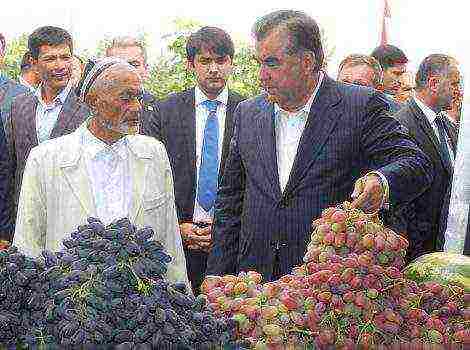Content
Most of the villagers traditionally grow onion sets. This method guarantees the harvest of large bulbs, and the planting material is consumed sparingly, because the size of the seeding plant allows it to be distributed over the garden at the desired distance. Far from everyone succeeds in growing this crop from seeds in one season, and the main reason for failure is the wrong choice of variety. But you can get excellent yields when sowing nigella onions by correctly selecting varieties and hybrids, and the cost of seed will be much less than when buying seedlings.
Onion varieties from seeds in one season
Pros and cons of annual growing
Besides cost savings, this method of growing has other advantages. First, onions from seeds are not susceptible to shooting, unlike sets, which require special storage conditions. Secondly, it is quite difficult to grow a high-quality set on your own, as well as to keep it until spring planting. But to obtain seeds, much effort is not required: it is enough to plant several large bulbs in the garden in the spring and collect flower stalks after ripening.
Growing and caring for onions
The downside is that only a limited number of varieties are suitable for annual cultivation, especially taking into account the seedless cultivation method. In addition, some of them, although they give large marketable bulbs, can only be stored until January. And one more thing: when sowing in open ground, the seedlings need enhanced care, since the sprouts are very thin, weak, and easily clogged with weeds.
Variety selection criteria
To get a good harvest, you need to choose the right variety.
When choosing a variety or hybrid of onions, you should pay attention to the following criteria:
- ripening terms. Early varieties form a bulb in 90 days, in mid-ripening vegetation lasts 110 days, late ripening takes from 120 to 130 days. As a result, some are intended for summer use and for greens, others are grown exclusively for turnip;
- the number of primordia in one plant. Small-sized (small-breeding) varieties most often give only one bulb, less often two, and are grown for a turnip. Multi-primordia form at least five pieces in a nest and give a lot of feathers to greens;
- the size of the root vegetables. Bulbs weighing up to 50 g are considered small, medium bulbs reach 120 g, large ones grow up to 400 g and more.
The taste of the onion is also important. As you know, it can be spicy, semi-sharp and sweet, used mainly in the preparation of salads. The characteristics of the variety are always indicated by the seed producers on the packaging, and a careful study of this information will help to avoid mistakes when choosing.
Seed onion in one year
The best varieties and hybrids of annual onions
There are many varieties of onions, both domestic and foreign selection. Below are only the most popular of them, suitable for growing in our latitudes and time-tested.
|
Exibition |
One of the most productive varieties of Dutch selection. In one season, it forms very large (about 500-600 g) bulbs of an elongated shape, golden in color. The scales are dense, juicy, and have a delicate sweet taste. Single-root variety, refers to salad, can be stored until about January. It is very rarely affected by diseases, it quickly adapts to bad weather conditions.It is recommended to grow it by direct sowing, without seedlings. |
|
Red Baron |
Refers to salad. Forms large purple bulbs with dense scales, juicy and bright taste. Bulbs grow up to 100 g, and with proper care and 120 g. The growing season lasts 110 days, the variety adapts well to various weather conditions. Most often it is cultivated as an annual, although it can also reproduce with sevka. Unlike other salad varieties, Red Baron keeps well until the next harvest. |
|
Shaman |
Early maturing low-germination variety with beautiful elongated bulbs. The upper scales are red-brown in color, the inner ones are bright pink. The taste is spicy, the mass of root crops is from 50 to 65 g. It grows well in compacted plantings, tolerates drought well, pleases with consistently high yields. It is recommended to grow through seedlings |
|
Centaur |
Mid-season and very productive. Bulbs are light yellow in color, round, rather dense. With the seedless method, the mass reaches 100 g, when grown by seedlings - from 200 to 300 g. It is practically not affected by downy mildew, resistant to other diseases. It tolerates temporary drought and a drop in temperature, it is well stored until late spring. Juicy bulbs have a pleasant sweet taste |
|
Delight |
A popular domestic low-germ variety. Vegetation lasts 130-140 days, with direct sowing, bulbs gain 150 g, when grown by seedlings - up to 300 g. Root crops are very dense, oval, straw-yellow in color. The taste is spicy. The variety is appreciated for its stable yield and undemanding care, excellent ripening, resistance to downy mildew. Keeping quality is high - the bulbs are well stored until June |
|
Crimson ball |
Early ripe salad variety. Bulbs are dense, purple outside, white inside with blue veins. The shape of the root crops is round, with an average weight of 80 g. This variety is valued for its yield and excellent semi-sharp taste. Unsuitable for long-term storage, mainly used fresh |
|
Agro winter |
It is considered one of the best winter varieties. Seeds winter well in the ground, germinate early, form large, very dense and juicy bulbs of semi-sharp taste. The color of the scales is white, the average weight of root crops is 90-100 g. Suitable for summer-autumn consumption, stored until January |
|
Karatalsky |
Domestic variety, small breeding, early. Forms flat-rounded dense bulbs weighing 120 g of semi-sharp taste. The outer scales are golden in color, the inside of the bulb is white and very juicy. Subject to agricultural technology, it gives consistently high yields in all weather conditions. Stores well enough, is disease resistant |
|
Olin |
Early ripe variety. Light yellow bulbs are round in shape, weigh from 80 to 120 g, have a semi-sharp taste. The advantages of the variety include excellent ripening, plasticity in cultivation, resistance to mechanical damage. Root crops are perfectly stored until the new harvest |
|
Siberian annual |
Very early variety suitable for winter sowing. Differs in increased cold resistance, gives excellent yields in the northern regions, forms a lot of juicy greenery. Forms flat-rounded bulbs weighing 80-120 g, with a semi-sharp taste. It is appreciated for its resistance to shooting and long-term storage without deterioration in taste. |
|
Farmer |
Mid-season, universal purpose. The bulbs are dense, round in shape, weighing up to 300 g, with a spicy taste. The color of the outer scales is dark golden, inside the bulb is white and juicy. It is grown by direct sowing and seedlings. It perfectly tolerates unfavorable conditions, is rarely affected by diseases, it is perfectly stored until late spring |
Hybrid onion varieties are also gaining popularity despite the higher cost of seeds. This is due to the fact that hybrids are more resistant to diseases, better stored and give good yields even on poor soils.The most demanded is the products of Dutch breeders.
Hybrid varieties of annual onions
|
Albion F1 |
An early ripe hybrid designed for universal use. Forms round, white onions, weighing 80-90 g, with a pleasant semi-sharp taste. It normally tolerates small cold snaps and dry periods, gives a stable harvest, is stored until December |
|
Daytona F1 |
Mid-season and cold-hardy. The shape of the bulbs is rounded, the color is dark golden, weight is from 50 to 100 g. The hybrid is three-pronged, forms a lot of juicy greenery, is practically not affected by fusarium and pink rot. Bulbs have a semi-sharp taste and can be stored well |
|
Esaul F1 |
High-yielding, mid-season. The bulbs are round, bronze in color, juicy, weighing from 120 to 150 g. The hybrid is small-germinated, usually forms one bulb, rarely two. Stored well, rarely affected by diseases, has a semi-sharp taste |
|
Copra F1 |
An early ripening hybrid recommended for cultivation in the central and southern regions. Shows excellent productivity even in dry years, can be stored until the next harvest. The bulbs have a semi-sharp taste, have a rounded shape, the average weight is about 100 g |
|
Cortland F1 |
Very reliable mid-early hybrid for central latitudes. Forms oval bulbs weighing 75-90 g, light brown color, with a semi-sharp taste. Valued for amicable ripening and uniformity of root crops, excellent adaptation to weather conditions |
|
Mars F1 |
Delicacy salad-type hybrid. The bulbs are round, red, white-pink inside, juicy. Average weight 200 g, semi-sharp taste. It is appreciated for its yield and quick adaptation to various growing conditions. Stored until February |
|
Mustang F1 |
Mid-season hybrid. The bulbs are golden, round in shape, with a very developed root system. Average weight 80-100 g, good density of scales, high taste. It is appreciated for its resistance to adverse weather conditions and excellent bulb ripening. Keeping quality is good, onion retains juiciness and pleasant taste for a long time. |
|
Sangro F1 |
New Dutch hybrid of medium ripening. Forms large (200-250 g) golden brown bulbs. Forms a large amount of greenery, when grown, root crops protrude from the ground by a third, which facilitates harvesting. It is prized for its high productivity, drought and disease resistance. Differs in a very long shelf life without deterioration in taste |
A few secrets of growing onions annually
High-quality seed is one of the most important conditions for obtaining marketable bulbs, but mistakes made during cultivation can nullify the result. There are certain secrets of onion agricultural technology that every gardener needs to familiarize himself with.
The most important thing is to choose the right seeds. Nigella onions very quickly lose their germination, and if the expiration date on the package expires in the year of planting, the seeds are considered already old and can only sprout 20-30%. It is best to sow seeds harvested in the previous fall, then the similarity will be at least 90%. With the high cost of varietal seeds, this is of great importance in terms of savings.
When and how to collect onion seeds (nigella)
Onion seeds germinate for a long time, and when grown in a seedless way, some of the sprouts are clogged with weeds and die. To prevent this from happening, it is recommended to pre-treat the seeds with a solution of potassium permanganate and soak them in water for a day. A growth stimulant can be added to the water.
Soaking onion seeds
After soaking, the seed is dried until flowable and sown in the ground. As a result of such actions, the seeds hatch faster, and the weeds do not have time to drown out the sprouts.
Sowing onions using a seeder
Onion shoots
A loose, nutritious soil and an open, sunny place are necessary for the formation of bulbs. The best precursors for onions are legumes, cucumbers, cabbage and potatoes.The garden bed should be prepared in the fall: it is well dug up, fertilized with rotted compost, mineral fertilizers are added. On dense soil, the bulbs are small, often do not fully ripen and are affected by rot.
To keep the onion well, watering is stopped no later than 3 weeks before harvesting.
The last time the onion is watered is a couple of weeks before harvest.
Harvested in warm, dry weather, and then dried for another week under a canopy. Subject to these conditions, everyone can grow large commercial bulbs from seeds.
Some secrets of harvesting onions
Video - Varieties of onions from seeds in one season
Hello dear readers!
Let's continue the conversation about growing onions and in this article I want to tell you about growing onions from seeds.
There are three ways growing onions from seeds:
- first - we grow onion sets, and already from it the next year - turnip onions;
- the second - in one year, we get turnip onions directly from seeds, planting them either very early in spring, or by seedlings;
- the third is winter sowing.
But first of all, before we start sowing seeds, let's decide what varieties we will plant.
The method of cultivation and the timing of planting largely depend on this. Now in Russia there are more than 60 varieties of onions, which can be divided into two groups: varieties of northern origin and varieties of southern origin.
Northern varieties need 16-17 hours of day length to form a full-fledged bulb, while southern varieties need 13-14 hours long.
Therefore, if we plant northern varieties in the south, then we may not get the bulbs. Southern varieties require more heat and have a longer growing season.
Also keep in mind that the northern onion tastes spicier and can be stored very well until the next harvest if stored properly.
Southern varieties have excellent taste, but they are stored for a much shorter time.
Most of the Russian onion varieties are long day onions. These are such varieties as: Strigunovsky, Bessonovsky, Arzamassky, Myachkovsky, Danilovsky, Rostovsky, Odintsovets and others.
Of the varieties of foreign selection, I recommend - Stuttgarter Riesen, Globo, Densimore, F1 hybrid Bonus.
And if you want to grow salad onions, then you can plant such southern varieties as: Spanish-313, Karatalsky, Lugansky, Krasnodar G-35, Kabo.
Growing onion sets
In the previous article, questions about the basic requirements for growing onions and preparing a plot for onions were highlighted, so we will not return to them, but proceed directly to the pre-sowing preparation of seeds and their planting.
Landing dates. First of all, we decide on the landing date, this is one of the most important points. Sowing is carried out as soon as the soil allows, because even with a slight (especially in dry years) delay in sowing, both the field germination of seeds and the yield and quality of seedlings are reduced. In this case, onion sets ripen very poorly and, most importantly, are not stored for a long time.
In central Russia, planting is best done in the last decade of April, if the weather does not bring any surprises.
And one more thing, although it is believed that nigella (also called onion seeds) retains its germination without loss for 2 years, but I advise you to still use annual seeds.
Seed preparation. First of all, let's check the seeds for germination, for this we place a few pieces of seeds between layers of damp cloth and put in a warm place. If after a while sprouts appear, then you can start preparing for sowing.
Next, we determine whether treatment is necessary for our seeds: the seeds that we buy in specialized stores have basically all already been disinfected (although there are exceptions), but the seeds that you yourself have grown, it is advisable to treat with any fungicidal dressing agents.
Or you can use a weak solution of potassium permanganate for this and keep the seeds in it for one day. It is very good to warm up the seeds for 30 minutes in hot water with a temperature of about 50 degrees, and also soak them in aloe juice for 30-40 minutes.
To speed up the emergence of seedlings (onion seeds germinate very slowly), soak the seeds in water at room temperature. This must be done 3-4 days before sowing.
Pour the seeds into a cloth bag, filling it in half, tie it and put it in water for 30-35 hours. During this period of time we change the water 3-4 times.
Then we sprinkle the already swollen seeds with a thin layer on a damp cloth, cover them on top with a second layer of damp cloth and leave them warm.
After two days, the seeds will begin to hatch and you can start sowing, but after we dry the nigella a little so that it becomes free-flowing, we mix it with chalk so that the seeds are better visible on the dark ground.
Sowing seeds. Sowing is carried out in a belt manner on a bed about 1 meter wide with very loose soil. Loose soil when sowing nigella is necessary because it will be very difficult for an onion sprout, which has the shape of a loop, to break through to the surface if we have dense soil or if we deeply bury the seeds in the ground.
In this regard, we sow seeds in grooves with a depth of 1.5-2 cm.It is advisable to maintain the distance between the seeds 1-1.5 cm.
The seeding rate of seeds is very important, since the growing season of the seed, as well as the quantity and quality of the crop, depends on it.
If we sow seeds rarely, then a large seed (samples) will grow, which will not have enough time for ripening.
If we sow the seeds often, we will get an immature small seed (non-standard), which is poorly stored and begins to germinate early.
Then we carefully close the grooves, compact the soil so that there are no air chambers between it and the seeds.
We mulch a bed with sown onion seeds with peat or humus with a layer of about 2 cm, and then water it carefully, trying not to blur the planting.
After that, it is advisable to cover the bed with plastic wrap in order to create a favorable water and air regime for the early germination of seeds. After emergence, the film must be removed.
Crop care. First of all, you need to carefully monitor so that a soil crust does not form and remove all weeds in a timely manner. If we have weeds on crops during the germination period, then the yield of onions decreases to 50%, and the ripening of the bulbs is very noticeably delayed.
With the formation of a soil crust, onion shoots are sparse and uneven, which also leads to a decrease in yield and a deterioration in its quality.
Sometimes weeds appear before onion shoots and there may be a danger of destruction of onion seedlings when weeding and loosening.
To prevent this, it is very good to add a little lettuce or radish seeds to the nigella seeds when sowing. They will emerge first and show us the location of the onion rows, and after the onion shoots, the beacon plants can be removed.
When the seedlings have 1-2 true leaves, we carry out the first thinning of crops in highly thickened places, leaving 1.5-2 cm between the plants.We carry out the second thinning after the formation of 3-4 leaves and leave a distance of 4-6 cm between the plants.
I would like to draw your attention to the fact that both weeding and thinning should not be delayed in any case, since otherwise thickening accelerates the formation of bulbs, the plants do not have time to form a sufficient number of leaves and the bulbs are small.
Water the onion plantings 1-2 times a week, provided the weather is dry, and only in the first half of the growing season (May - June). Then we stop watering, as the bulbs are ripening.
And 1 week before harvesting, it is recommended to carry out foliar top dressing of crops with potash fertilizer, as this contributes to better ripening of the seedlings.
Harvesting, preparation for storage and storage features. We start harvesting onion sets in the second half of July - August (depending on the weather), as soon as the leaves turn yellow by a third of the height.
You can read about harvesting onions and preparing them for storage in the previous article on onions.
It is necessary to store the grown onion sets in different ways, depending on its size. Therefore, first of all, we will sort it into small ones with a diameter of up to 1.0 cm, medium - 1.5-2.5 cm and large - more than 3 cm.
Sevok is best stored in cloth bags and in a dry, well-ventilated area. For shallow seedlings, the optimal storage temperature is 0 ° C, because since it tends to dry out, at a higher temperature such onions can completely die.
The problem of storing small sevka (non-standard) can be solved by planting it before winter, because it does not shoot under any conditions and can give an excellent harvest of turnip onions.
Medium and large seedlings keep well at room temperature (up to 18 ° C). At higher or lower storage temperatures, the onion sets may go to the arrow after planting.
Onion-turnip from seeds in one year
It is quite possible to grow onions from seeds in one year. Our resourceful summer residents have learned to do this very successfully, using two methods: firstly, the early spring thickened sowing of seeds; secondly, it is growing through seedlings.
The most suitable varieties for such onion cultivation are Myachkovsky, Strigunovsky and Odintsovets... The varieties are also good Russian size and Exibition, which have very large bulbs (350 g, and sometimes up to 500 g) of a delicate, sweet taste.
Now let's take a closer look at each method.
Early spring landing. Early varieties are most suitable for growing onions in this way, and onions grown in this way will not be stored for so long, so it is best to use them first.
It is recommended to start sowing around April 20-25 (we look at the weather). We warm the seeds, disinfect, germinate and sow very early on the beds prepared in the fall.
The beds should be covered with plastic wrap in advance so that the ground warms up well before planting the seeds.
On the day of planting, we remove the film from the garden, make grooves and spill them with hot water. Then we spread the seeds, sprinkle them with humus or compost, compact the soil and cover the bed again with foil.
We remove the film from the garden only when shoots appear.
Further planting care is the same as for onions, which we grow from sets. The only difference is the need for planting thinning.
The first time the onion should be thinned when it reaches 7-10 cm. The second thinning is carried out after 3 weeks and the third - 2-3 weeks after the second.
As a result, the distance between the bulbs should be about 10 cm. With this method of growing onions, it is very important that the bulbs have time to fully ripen.
To somehow speed up this process, you can do the following:
- In the second half of the growing season, undo the bulbs so that they are half above the ground.
- Pull the bulbs slightly by the feather, as if lifting them in the ground, or slightly prune the roots with a shovel.
With these actions, the process of supply of nutrients from the leaves to the bulbs is significantly accelerated and their ripening is faster.
Some summer residents, in order to accelerate ripening, crush onion leaves, but this method is dangerous because pathogenic bacteria or pests can get into the neck of the bulb.
With this method of planting, it is quite possible that not only onions will grow from seeds, but also onions and onions. Therefore, after harvesting and drying the onion, it must be sorted into large (more than 4 cm), medium (3-4 cm) and small (up to 3 cm).
Then we leave large bulbs for winter storage; medium onions must be consumed first, they are also suitable for forcing green onions; small bulbs (sets) we leave for storage for spring plantings.
Onions through seedlings. Growing onions through seedlings is, of course, troublesome, but not difficult. But there are many advantages: firstly, the onion ripens perfectly by the fall, not at all worse than planted with a set; secondly, at the same time, we get a yield twice as large as when sowing seeds directly into open ground.
We sow seeds for seedlings at the end of February - the first half of March. We grow onion seedlings at home in boxes, seedling pots or other containers with a height of at least 10 cm.
The main condition is that the walls of the containers should not be transparent, as light will interfere with the development of the root system.
Seeds can be sown into 1 cm deep grooves or simply planted densely over the entire area of the container.
Then we cover them with a layer of earth (1 cm) on top, slightly compact, carefully water (preferably from a spray bottle, so as not to wash the seeds out of the soil) with warm water and put the container in a warm place (22-25 ° C), covered with a film.
After about 10-15 days, shoots begin to appear and the film is removed. After the sprouts (loops) appear, the containers with seedlings are placed in the brightest place, while it is desirable to maintain the air temperature at 9-12 ° C for 3-5 days.
Then it is recommended to increase the temperature to 15-20 ° C during the day and 10-12 ° C at night. If the air temperature in the room is higher, then regular ventilation is necessary so that the seedlings do not stretch out and do not get sick with a black leg.
In addition, if the seedlings grew at an elevated temperature, then later, when planted in the ground, they do not take root well.
Water the seedlings of onions sparingly, do not overmoisten the soil. Before planting the seedlings in the ground, we feed it two times, but if it grows strong and healthy, then you can feed it once.
We carry out the first feeding one week after germination, and the second two weeks after the first.
A solution for dressing can be prepared from both mineral fertilizers and mullein infusion by stirring in water in a ratio of 1: 6.
We feed very carefully - little by little.
At the age of about 60 days, the seedlings can already be planted in the garden. By this time, it becomes strong, has a developed root system, 3-4 true leaves and a thickness of 3-4 mm at the base.
Usually, onion seedlings are planted in the garden from May 1 to May 10, depending on the weather in the region and on the condition of the soil. She is not afraid of small frosts.
The best time to plant is in the afternoon, when the air temperature is already starting to drop. Before transplanting, water the seedlings well, then carefully remove each plant from the ground.
If the roots are long, then they need to be shortened a little, by about one third. This is done so that when planting, the roots do not bend upwards, since the plant survival rate decreases.
We plant onions in rows with a distance between plants of 8-10 cm, between rows - 20-25 cm.If you are planting large varieties of onions, it is better to adhere to the scheme of 30x30 cm.Immediately after planting, we water the garden well.
Later, during the first week, until the plants take root, we water every day, keeping the earth moist. Then watering should be carried out as the soil dries.
The following agrotechnical measures are no different from those that are used in the cultivation of onions in other ways, namely: weeding, watering, loosening, feeding, harvesting.
On this, perhaps, the article will end. In it, I told you about growing onions from seeds in two ways: with a two-year culture - we grow onion sets, and already from it the next year - onion-turnip and one-year old - in one year we get turnip onions directly from the seeds, planting them either very early spring, or seedlings.
We will talk about the third method - sowing podzimm - in one of the subsequent articles.
See you soon, dear readers!
You can also read on this topic:
Tags: onion

Table of contents:
- Reasons for using seedlings
- Used onion varieties
- Ways to grow onions from seeds
- Presowing seed preparation
- Preparing the beds for sowing
- Sowing onion seeds
- Crop care
- Harvesting ripe crops
Onions are one of the healthiest plants in the garden. It contains in its composition special substances (phytoncides) that kill pathogenic bacteria. These substances give the onion a pungent taste and a peculiar smell, while endowing with healing properties. When added to a dish, it leaves a special aftertaste, and also helps to improve digestion and assimilation of food.
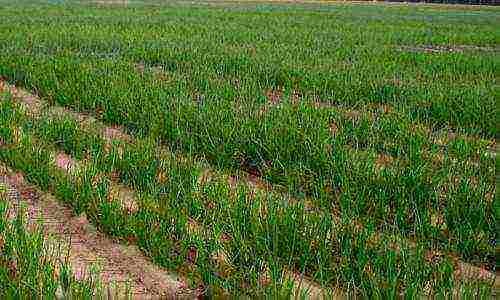
Onions in the greenhouse grow quite quickly. Usually it is cut when young.
The most common onion variety in our country is onion. Onions are grown almost everywhere. However, to get a large and healthy onion, you need to spend a lot of time and effort. As practice shows, the optimal scheme for growing onions is: seeds - sets - samples - turnip. This setup produces large, strong bulbs in almost any setting, but is time consuming.
Therefore, in recent years, growing onions from seeds has gained popularity, which allows you to get a ready-made harvest in one season.
In addition, full-fledged turnip onions are better stored in winter than sets, and planting material is much cheaper.
Reasons for using seedlings 
Greenhouses are often grown for sale. In winter, it is most in demand.
There are several other reasons why it is easier to use onion seeds than onion sets.
- when using onion sets as planting material, it is possible to bring pests or diseases to the beds. Even when using a manganese solution as an antiseptic, the complete absence of diseases or pests in the body of the seed cannot be guaranteed. It is much easier to pickle seeds for sowing;
- sowing onion seeds allows you to grow marketable onions in a season, even without seedlings. Depending on the growing conditions and the applied dressings, you can get full-fledged bulbs even with late sowing directly into the ground;
- growing seedlings avoids crop failure due to poor quality material. When using turnip onions, there is a high probability of getting heterogeneous plantings with numerous voids;
- with seed growing, it is possible to select the strongest plants and plant them at an optimal distance from each other so that they do not compete for space and nutrients.
Back to the table of contents
Used onion varieties 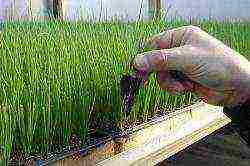
For growing green onions, take small bulbs, 3-5 cm in size.
There are several varieties of onions that are best suited for seed growing in our environment:
- Timiryazevsky, which is characterized by early maturity and high keeping quality. The bulbs are round, light brown in color. Each nest produces 2-3 bulbs;
- Danilovskiy 301, characterized by sweetish taste and good keeping quality. This variety is semi-sharp and mid-season. The bulbs are round-flat and purple in color. Usually only one bulb grows per nest;
- Strigunovsky is a spicy variety with good keeping quality. The bulbs are round, yellow. Onions can be grown from seeds in one season. When grown, 1-2 bulbs are formed in the nest;
- Rostov is a sharp and early ripening variety with high keeping quality. The bulbs are flat, round and yellow in color. The nest usually contains up to 4 bulbs;
- Bessonovsky is a spicy early-ripening variety with good keeping quality. Rounded bulbs are yellow in color. Quite fertile, as in each nest from 3 to 5 bulbs are formed;
- Arzamas, characterized by a pungent taste, but medium ripeness. The bulbs are round-elongated, with a yellow color. 1-2 bulbs grow in the nest;
- Svirskiy is a semi-sharp variety with an average ripeness and good keeping quality. The bulbs are round-flat, yellow in color. Only 1-2 bulbs grow in the nest;
- odintsovets is a sharp early ripening variety with good keeping quality. Rounded bulbs are yellow in color. One of the most optimal varieties for growing a turnip in one summer;
- Carmen is a semi-sharp mid-season variety. It takes 120-130 days from germination to harvest. Harvestable. The bulbs are round, with a characteristic dark red color;
- zolotnik is a sharp early ripening variety with good keeping quality. The bulbs are round and yellow in color. Can be used for growing both turnip and set;
- Stuttgarten Riesen is a mid-season variety with a spicy taste. From sowing to harvesting, 120 days pass. Large, dense, rounded bulbs have a yellow-brown color and good keeping quality.
Back to the table of contents
Ways to grow onions from seeds 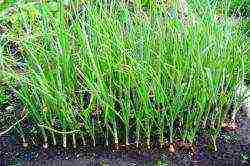
Onions are a perennial herb of about 400 species.
Growing onions from seeds can be carried out in several ways: by sowing directly into the ground in early spring, sowing before winter and growing seedlings.
In the first option, onion seeds are sown in the ground immediately after it thaws. With this method, the bulbs have time to ripen in one season.
Podzimny sowing is carried out in the fall in slightly frozen soil. You should be careful, because with an earlier sowing, onions can germinate in the fall, which is fraught with freezing.
With the seedling method, seeds are germinated at home from February, and planted in the ground in April.
For any sowing method, it is necessary to prepare the soil in advance. For this, the land is dug up in the fall with the introduction of peat or compost and mineral fertilizers.
Back to the table of contents
Presowing seed preparation
A month before planting, the seeds must be checked for germination. To do this, you need to take 15-20 seeds from a batch and keep them in a damp cloth for a couple of weeks. The results of this test can be used to judge whether it is worth using these seeds for sowing or buying others.

Scheme of the neighborhood of vegetables by type of fertilizer.
If you are satisfied with the germination of seeds, then pre-sowing preparation of seeds is carried out. In order to avoid fungal diseases, the seeds are immersed in hot water (45-50 ° C) for 15 minutes, previously wrapped in a cloth, and then in cold water for 1 minute. After this treatment, the seeds are soaked for a day in warm water (22-26 ° C). After soaking, the seeds are kept for 1-2 days at room temperature, still wrapped in a damp cloth, which must be periodically moistened.
Presowing preparation can be done in another way. To do this, oxygen is supplied under pressure to a container with water and the seeds are soaked in it for 18-20 hours. After soaking, the seeds are dried and sown on the prepared soil.
The average sowing date for onions is April 20-25.
Back to the table of contents
Preparing the beds for sowing
Onion beds are best placed in sunny locations. It should be borne in mind that onions are best planted in beds that have previously grown cucumbers, legumes, cabbage, tomatoes or potatoes, since these crops supply the soil well with nitrogen. Onions grow well on loams with the introduction of organic and mineral fertilizers.
The width of the beds should not be more than 80 cm, and the height should not be more than 15 cm. When digging, 3-4 kg of compost or 2-3 kg of peat are introduced into the soil for each square m of area. Together with them, nitrophoska is introduced into the soil in combination with superphosphate (one tablespoon per the same area) or nitroammophoska with wood ash. Both compost and fertilizer must be carefully moved with the topsoil and lightly tamped down from above.The prepared bed is spilled with a solution of copper sulfate in a proportion of 1 tablespoon per bucket of water with a consumption of 2 liters for each square meter of the bed. After all the actions, the bed is covered with plastic wrap and kept until sowing for 2-3 days.
Back to the table of contents
Sowing onion seeds
Before sowing, markings are made on the garden bed. 10 cm recede from the edge of the bed and three furrows are drawn at a distance of 5 cm from each other. The depth of the furrows should not exceed 2 cm. Three more furrows are drawn at a distance of 15 cm from them, etc.
Seeds are sown into the prepared furrows at a distance of 1-1.5 cm from each other. After sowing, the soil is slightly compacted and carefully watered with water at a rate of 2-3 liters of water for each m of the garden.
In order to accelerate the germination and growth of seeds, the beds are covered with a film stretched over arcs at a height of 20-30 cm above the surface. This will make it possible to maintain soil moisture and create an optimal microclimate for germination.
After germination, cotyledons in the form of small loops should appear on the soil surface. If roots appeared instead of them from the soil, then such plants must be removed from the garden, they will die in any case. After mass germination of seeds, it is worth thinning so that the distance between neighboring plants is at least 1.5-2 cm. After 12 days, the cotyledons are usually straightened, and the first leaf appears.
Back to the table of contents
Crop care
The main indicators of onion care are timely watering, weeding, and pest and disease control.
Watering is carried out once a week from May to June. If the weather is dry, then watering can be done twice a week. Water consumption is 5-10 liters for each m of the garden. In July, watering stops, as they interfere with the ripening of the bulbs. If the weather is still hot, you can water it once a week in small doses to keep the bulbs from wilting. Water it carefully to avoid breaking the feathers.
Weeding the beds should be carried out when small weeds appear. If you weed out already mature weeds, you can damage the roots of the bulbs, and they will not ripen. Before weeding, the beds are spilled abundantly to facilitate the weeding process. Weeding not only removes weeds, but also partially loosens the soil. Separate loosening is not carried out.
With slow leaf formation, urea can be fertilized. A spoonful of urea is dissolved in a bucket of water and the onion is poured at the rate of 3-4 liters per m2.
Back to the table of contents
Harvesting ripe crops
A signal that the onion is ripe is yellowing and wilting of its feathers. Usually, the harvest is carried out from July 25 to August 10. If the feathers have not turned yellow, then the onions are collected from the garden and laid out for several weeks in the sun in a thin layer to ripen.
After complete drying, the leaves are removed, and the bulbs themselves are carefully dried using heating devices or a stove. Such drying will protect the onions from rot and powdery mildew.
After drying, the onions are sorted. Small bulbs (1-1.5 cm) are used for planting before winter. The rest of the onions are stored in boxes or canvas bags of 10-15 kg in a dark place at a temperature of about 18 ° C. If the storage temperature is higher, it can lead to germination of the bulbs. The onions are periodically checked for rot and dried onions, which are removed in a timely manner.
Properly grown onions will be an excellent source of vitamins and health benefits for your family all year round.
Traditionally, onions are grown using a scheme in which onion sets are obtained from nigella sown in autumn or early spring, and samples are obtained from it. It is planted a year later and only then do they get onions. This makes it possible to get a good harvest of the product, but the process lasts two seasons. Therefore, growing onions from seeds is becoming more and more popular.
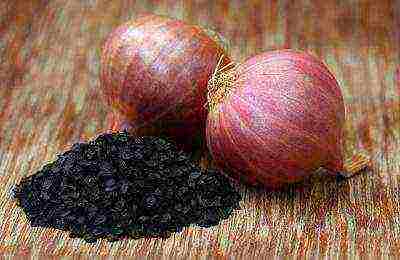 This method makes it possible to collect turnip onions in one season and is more economical, since seeds are cheaper than seed sets. And onions grown from seeds are preserved better. Another important factor should be noted: onion sets produce a large number of arrows that must be removed in time. As a result, not only the process of growing the bulb is complicated, but also its quality often deteriorates.
This method makes it possible to collect turnip onions in one season and is more economical, since seeds are cheaper than seed sets. And onions grown from seeds are preserved better. Another important factor should be noted: onion sets produce a large number of arrows that must be removed in time. As a result, not only the process of growing the bulb is complicated, but also its quality often deteriorates.
Benefits of the seed method
It is more advisable to plant onions with seeds for many reasons. Here are the main ones:
- Using onion sets purchased from an unscrupulous seller, you can introduce various diseases and harmful organisms into the soil. Processing it with a solution of potassium permanganate does not always give 100 percent getting rid of them. Seed dressing is easier and safer.
- Onions from seeds can be grown in one season without seedlings - using sowing directly into the soil. True, this requires favorable conditions and high-quality plant nutrition.
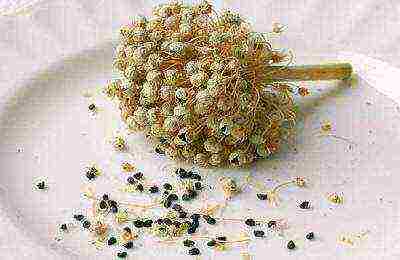 This method will guarantee a higher yield. This is due to the fact that turnip onions can give poor germination due to the likelihood of acquiring poor-quality planting material, as a result of which a large number of voids arise.
This method will guarantee a higher yield. This is due to the fact that turnip onions can give poor germination due to the likelihood of acquiring poor-quality planting material, as a result of which a large number of voids arise.- Seed cultivation involves the selection of high-quality shoots and their even distribution. This makes it possible to create comfortable conditions for each plant, as well as provide them with the necessary nutrients.
Note! To obtain good results, you should be responsible for the choice of plant variety.
What seeds should you use
It must be remembered that the germination of onion seeds directly depends on the shelf life. When buying them, it is advisable to choose those that have a two-year time reserve. In this case, you can get 90 percent germination.
Seeds with a shelf life ending in the planting year are considered old - their permissible germination rate is no more than 35 percent.
Having thought about how to grow onions from seeds, you should first find out which varieties are most suitable for this purpose. Here are some of them:
- variety Danilovskiy 301 - mid-season, sweetish, purple, slightly flattened;
- Timiryazevsky variety, characterized by high productivity (up to 2-3 bulbs in one nest), round shape, light brown color;
- the Rostovsky variety, characterized by early maturity and piquant sharpness, there can be up to four bulbs in the hole;
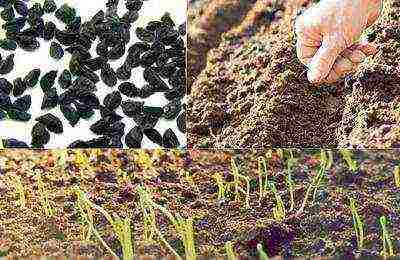 Svirsky onion, which is characterized by a pleasant semi-sharp taste;
Svirsky onion, which is characterized by a pleasant semi-sharp taste;- Strigunovsky variety - very spicy in taste;
- Bessonovsky variety - has a high yield (up to 5 pieces in a nest);
- Carmen variety - dark red with a delicate spicy taste;
- grade Zolotnichok - ripens early, sharp, stored for a long time;
- Stuttgarten-Riesen variety - characterized by piquant taste, mid-season.
This list can be continued by Arzamas, Odintsovets, Chalcedony, Exibishen and Carmen MC.
You can grow bulbs in one season from seeds using three methods:
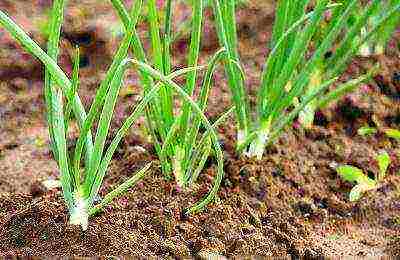 sowing in late autumn in the beds;
sowing in late autumn in the beds;- spring sowing - directly into the ground;
- pre-prepared seedlings.
The first method involves planting nigella after the first small frosts. This is done in order to prevent premature germination of seeds and the threat of their death from severe frosts.
When sowing in spring, it is advisable to plant the planting material immediately after thawing the soil. To obtain seedlings, sowing of nigella is carried out after February 25, in order to plant it in the prepared soil in April.
Tips from PROFESSIONAL GARDENERSMany of our readers for a RICH HARVEST actively use effective biofertilizer
Biogrow... This fertilizer is suitable for all types and varieties of cultivated plants. Allows
increase yields by 50%NO hazardous chemicals. And all that is needed for this is to add biofertilizer to the soil 2-3 times per season.
Preparatory activities
The preparatory stages are of no small importance for obtaining a high yield of onions in one season.
-
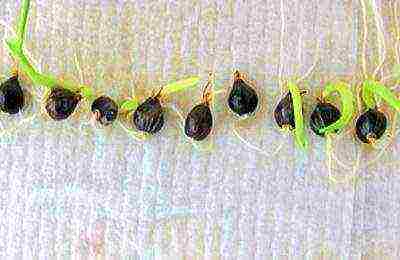 Seed preparation. It consists in germinating seeds in order to test them for germination. This is done in advance as follows: 10-15 seeds are placed in a damp rag for a period of 10-15 days. If the seeds are of good quality, about 80% germinate. At a lower rate, it is better to change the seeds.
Seed preparation. It consists in germinating seeds in order to test them for germination. This is done in advance as follows: 10-15 seeds are placed in a damp rag for a period of 10-15 days. If the seeds are of good quality, about 80% germinate. At a lower rate, it is better to change the seeds.After checking nigella for germination, it should be treated with a pale pink solution of potassium permanganate in order to avoid fungal infections. You can carry out preventive treatment in another way. The seeds, wrapped in a soft cloth or napkin, are immersed in water heated to 50 degrees, kept for 12-15 minutes, and then put into cold water for a minute.
Soak the processed nigella in boiled and cooled water to 25 degrees for 24-25 hours. Then, for about two days, the seeds should be kept in a wet napkin, which should be sprinkled with water from time to time. Seeds are sown in the last days of April - 28-30.
-
The process of preparing the beds. To make the bulbs feel comfortable during the entire ripening period, preliminary soil preparation is provided. In the fall, you should dig up the earth, fertilize it well with various additives. The beds are placed on the sunny side.
Acceptable dimensions: width - about a meter, height - 10-12 cm. The soil should be treated with copper sulfate. For this, a tablespoon of the drug is added to a bucket of water. For one square meter of soil, two liters of the prepared solution are enough. This procedure should be carried out 3-4 days before planting the seeds.
Rules for sowing seeds in the ground
The garden bed, prepared for the spring or autumn planting of nigella, should be correctly marked. The best option: the width between the grooves is 15-20 cm, the depth is about two cm.Along the edges of the bed there are indents of 10 cm.
-
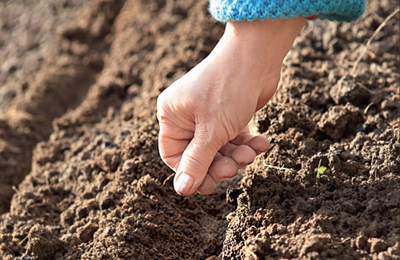 Spring landing. The seed of nigella must be placed in the garden at a distance of one and a half centimeters from one another. The seeds can be sprinkled with grated chalk or tooth powder, which will make it possible to plant them more evenly. The soil should be lightly compacted and sprinkled with sawdust.
Spring landing. The seed of nigella must be placed in the garden at a distance of one and a half centimeters from one another. The seeds can be sprinkled with grated chalk or tooth powder, which will make it possible to plant them more evenly. The soil should be lightly compacted and sprinkled with sawdust.To avoid the formation of a crust that prevents seedlings, do not water. When all the seeds sprout, the distance between the shoots is adjusted, which have two to four feathers. Now it should be at least five cm.
- Winter sowing. The garden bed is prepared in a similar way. After the first frost, the planting material is sown into the grooves and must be sprinkled with sawdust. So that the seedlings do not die from frost, it is necessary to sprinkle the bare places with snow, and in the spring, after the snow melts, you can sprinkle it with two-year humus (no more than one cm). The whole subsequent process takes place as with spring sowing.
-
Features of planting seedlings. Using this method, work should begin in early March. When growing seedlings in a greenhouse or on a windowsill, you can use boxes with soil harvested in the fall. When marking, the dimensions are the same as in the first two cases, but 5 centimeters are enough between the rows.
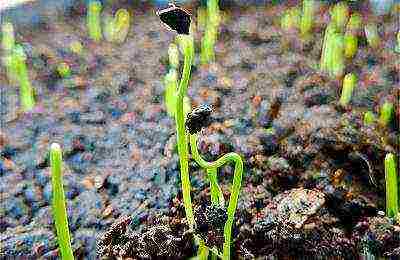 Before the first shoots appear, the temperature is at least 20 degrees, then: 12-15 during the day, 7-8 at night. In the presence of comfortable conditions (light, warmth, moisture), by the last days of April, three or four feathers will form in the seedlings, the height is 10-15 centimeters.
Before the first shoots appear, the temperature is at least 20 degrees, then: 12-15 during the day, 7-8 at night. In the presence of comfortable conditions (light, warmth, moisture), by the last days of April, three or four feathers will form in the seedlings, the height is 10-15 centimeters.
These indicators and normal weather conditions make it possible to transplant plants into open ground. Marking: row spacing - about 40 cm, between seedlings - up to 5 cm. The soil must be slightly crushed to the stem. After 1 - 2 days, the plants must be watered, the soil must be loosened.
How to care
Caring for plants grown from seeds in one season is no different from the usual requirements. This is:
 watering until mid-July (once or twice a week);
watering until mid-July (once or twice a week);- timely weeding;
- disease prevention.
There are disagreements regarding soil loosening. Some growers recommend loosening the soil after almost every watering. Others warn that this can damage the plants, especially since partial loosening is done during weeding.
Weeding is carried out as soon as weeds appear, preventing their overgrowth, since when removing large weeds, there is a high probability of damage to the onion roots.
Watering in the second half of July can cause late ripening of onions.
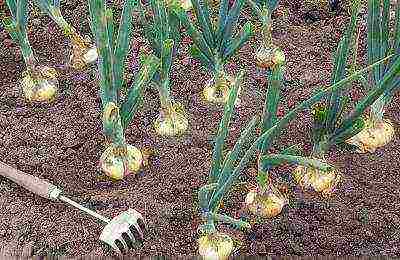 To protect plants from pests, you can use an infusion, which includes wormwood, dandelion (leaves), stepsons removed from tomatoes, peppercorns. Raw materials are taken in any amount - about a liter can for 10 liters of water. Pepper - 5-6 peas. Pour the vegetable mixture with boiling water, insist for a day, strain. Two liter cans of infusion are added to eight liters of water - you can water the soil. The remaining mixture should be stored in the refrigerator for the next watering.
To protect plants from pests, you can use an infusion, which includes wormwood, dandelion (leaves), stepsons removed from tomatoes, peppercorns. Raw materials are taken in any amount - about a liter can for 10 liters of water. Pepper - 5-6 peas. Pour the vegetable mixture with boiling water, insist for a day, strain. Two liter cans of infusion are added to eight liters of water - you can water the soil. The remaining mixture should be stored in the refrigerator for the next watering.
Harvesting and storage of crops
The readiness of the onion can be judged by the wilting of the tops. Optimal harvest time: the last days of July - early August. In some cases, the feather does not always turn yellow by this time. In this case, collect the bulbs and leave them to ripen, laid out in one layer with the feather.
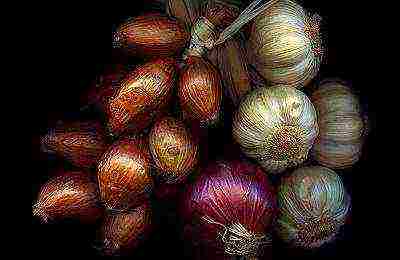 In the future, the dry feather is removed, the onion is dried well to prevent the appearance of putrefactive processes. It is necessary to store onions in boxes, observing a temperature regime of no more than 18 degrees. At higher temperatures, onion germination is possible. An important element of storage is regular checking for the appearance of spoiled onions, which should be removed in a timely manner to avoid the spread of rot.
In the future, the dry feather is removed, the onion is dried well to prevent the appearance of putrefactive processes. It is necessary to store onions in boxes, observing a temperature regime of no more than 18 degrees. At higher temperatures, onion germination is possible. An important element of storage is regular checking for the appearance of spoiled onions, which should be removed in a timely manner to avoid the spread of rot.
Growing onions from seeds can seem like a daunting process. But when comparing it with planting from onion sets, the high cost of the latter method is obvious.
In addition, compliance with all the rules will make it possible to grow an excellent harvest not only at low cost, but also with an obvious difference in yield.
The reliability of the seed method is a priority due to the fact that the loss of yield due to the abundance of arrows that spoil the bulbs is completely excluded. But each gardener decides for himself which method suits him best.
Do you still think that getting rid of cardiovascular diseases is impossible?
- do you often have pain and discomfort in the chest?
- it seems to you that the heart is almost "jumping out" of the chest, then freezes for a while ...
- you have shortness of breath even after minor physical exertion….
- headaches, poor sleep, feelings of weakness and increased fatigue ...
- legs swell in the evening ...
Stop enduring, you can no longer wait, delay treatment. Read what Elena Malysheva advises for both treatment and prevention of diseases of the cardiovascular system ...

about the author
Project expert
Helpful article?
